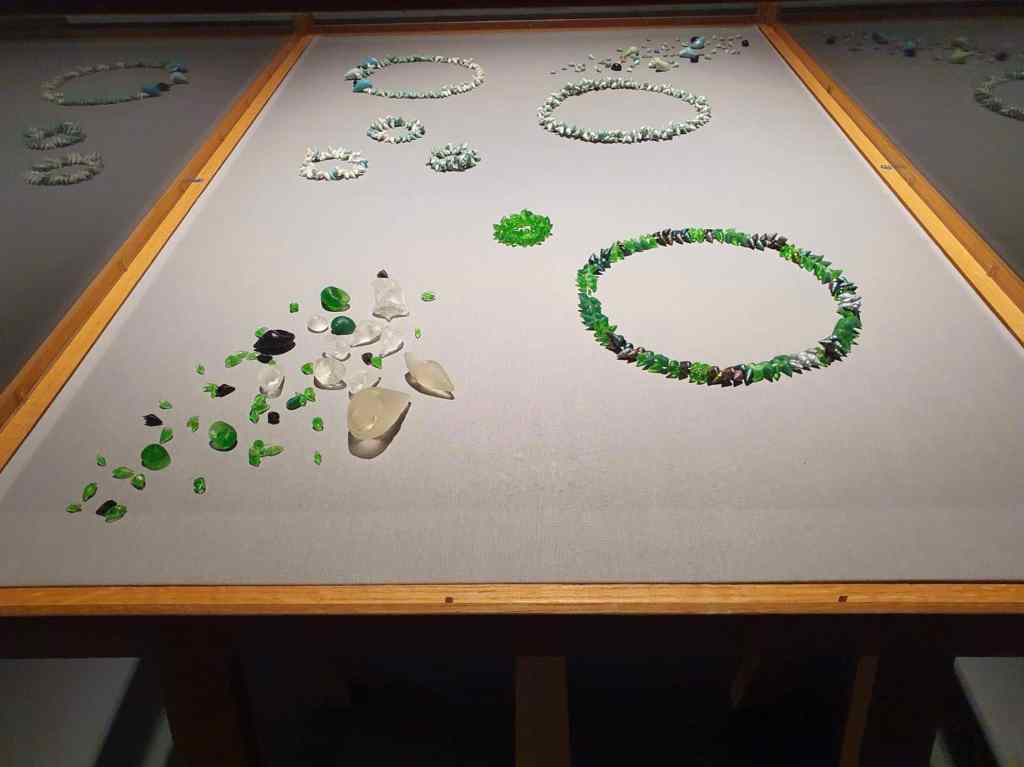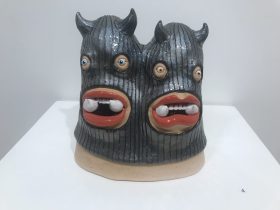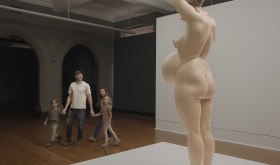Protecting kanalaritja is Andrew Gall’s doctoral exhibition. A Pakana man from Lutruwita/Tasmania, Gall expands contemporary jewellery and wearable art practices to investigate past and current Indigenous Australian narratives of identity and continuity, heritage, tradition and cultural loss.
In Tasmanian languages, the term kanalaritja is used interchangeably to render both pierced shell necklaces and the making of them – the collecting, cleaning and stringing of shells. The longest, continued Pakana tradition, kanalaritja withstood invasion, atrocity and dispossession. It was guarded and preserved to the present day by the efforts of a small group of Tasmanian Aboriginal women, some of them members of Gall’s extended family.
For the past 20 years, however, the number of shells available for collection has decreased. Due to climate change, suitable seabeds for shell harvesting are continuously eroding and intense storms are tossing or burying away the sought after shells. Such concerns threaten the lasting tradition of kanalaritja.
To make up for the scarcity of natural resources, Gall explores 3D scanning, drawing and printing technology, and creates shells from various types of resins, chemicals, plants and ceramics. With Tests-Successes-Failures (2018-23), the artist provides an unequivocal visual explanation of his experiments. Various 3D resin prints, shells, support structures and build plate supports, underscore the permanence as well as the variability of the rendering of shell. Integral to artistic processes, the failed artefacts hold on to the moment of creation, conveying new dimensions for Pakana customary art-making.
Searching for ways to preserve his cultural heritage and ensure the continuity of shell stringing, Gall fuses digital fabrication technology with Pakana cultural knowledge.
His daughter, Alana, and granddaughters, Zyana and Qila, string the printed shells into several kanalaritja. ‘My work is grounded in my Pakana culture and knowledges. It informs all aspects of what I do and how I do it – my thinking around what I do and how I problem solve and innovate, and the motivations and driving forces behind my work,’ explains Gall.
Two photographic portraits of Zyana, Coming Together (2023) and Not Kanalaritja (2021), fill the gallery’s furthest left space. Yet, Zyana doesn’t seem to wish to be looked at. Involuntarily attempting to track her gaze, I find myself in an unnameable space of dispersal and loss. In Coming Together, the young woman wears a kanalaritja porcelain necklace, whereas in Not Kanalaritja stringed resin shells adorn her hair.
On the opposite wall, Kanalaritja (2017) features a rare and precious natural two-strand necklace created by Auntie Vicki-Laine Green.
The juxtaposition of imagery and artefact reveals the tensions of disappearance and preservation. Four wide display cases host a richness of kanalaritja – porcelain, resin or silver varieties. Among them, Real to Facsimile (2023) is a comparative piece that brings together collected natural shells with silver, hollow or solid 3D printed resin and porcelain ones. Absence and presentness sit alongside each other, turning the viewers into witnesses.
Read: Significant object heads home to Tasmania after 230 years
New knowledge, ganma, interweaving Indigenous knowledges and contemporary Western technologies, is formed. Protecting kanalaritja becomes a project of identity politics and renewing of Pakana
cultural patrimony.
Andrew Gall, Protecting kanalaritja will be on display until 4 March 2023.
Webb Gallery, Queensland





